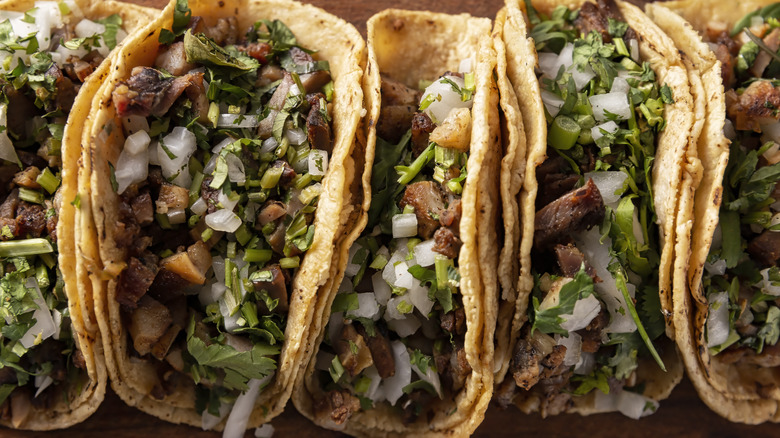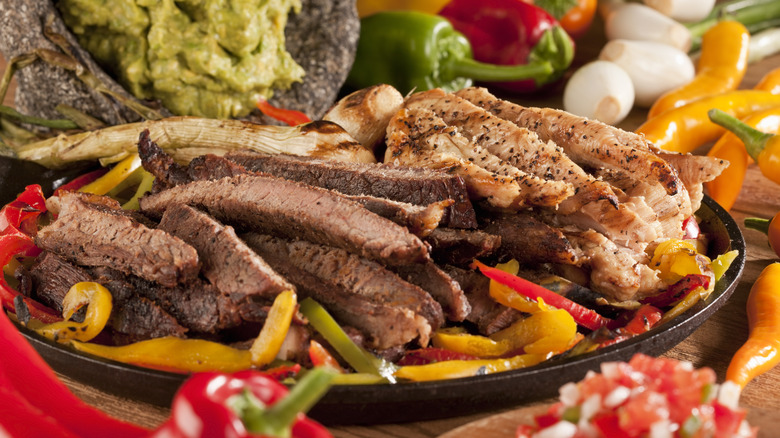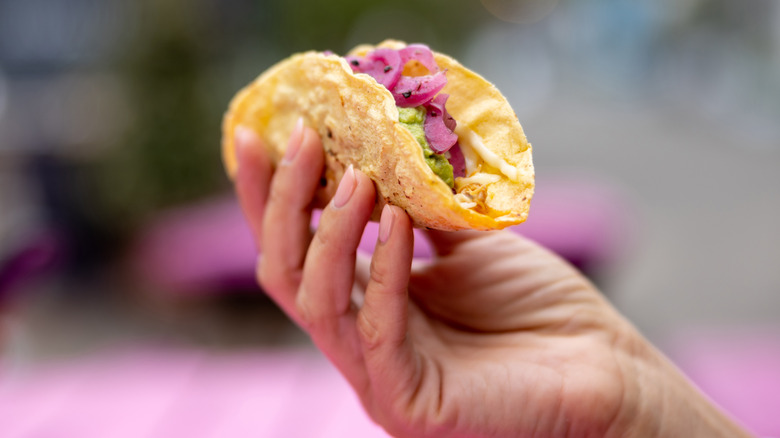The Exact Difference Between Fajitas And Tacos
Fajitas and tacos: Both of them can feature a mix of meats and vegetables, delectably laid out on soft tortillas. But despite this overlap, they're certainly not the same thing. At the most basic level, fajitas feature grilled meats, peppers, and onions, often presented on a sizzling platter — diners can then stack these grilled goods onto flour tortillas with other toppings. Tacos, meanwhile, are a much more portable food, involving tortillas (corn or flour) stacked with a concoction of meat and usually fresh vegetables and condiments, and folded in half to eat. You'll typically order a taco by the name of its filling — for example, carnitas (shredded, slow-cooked pork) or tinga (chicken with tomato and chipotle). Seasonings like cumin, chile, and garlic are common in both, although since there's a very wide range of taco fillings and seasonings, this won't always be the case.
The two foods have different histories, too: fajitas are a relatively recent invention, created by Mexican ranch workers in western Texas in the early-to-mid 1900s, before getting popular later in the century. (This means they're probably better described as a Tex-Mex dish, rather than Mexican.) Tacos are harder to pin down — corn (and by extension, tortillas) have been part of Mexican cuisine for centuries, so as a result, taco-like dishes have been around for hundreds of years. The term "taco" is newer, probably from Mexican silver miners in the 18th century, while Americanized versions of tacos (hello, Taco Bell) started to appear in the 20th century.
What makes a fajita?
When Mexican ranchers in Texas devised the fajita, it was made with marinated skirt steak, and closely resembled Mexican-style carne asada. The dish has since evolved, and it can involve other proteins like pork or chicken — basically, anything that grills well. The meat is marinated, usually with characteristic Tex and/or Mex flavors like garlic, paprika, chile, and oregano. Ever since they appeared in restaurants, they've been served sizzling-hot on a cast-iron skillet or platter, often with peppers and onions among the grilled meat. Fajita meat is always grilled, in contrast to tacos, where the filling is more variable and could also be braised or fried.
Tortillas and other toppings come on the side — the tortillas tend to be flour (sometimes called wheat) but this isn't a firm rule; there's nothing stopping you from using corn ones. The toppings hover between American and Mexican flavors: Guacamole, pico de gallo, grated cheese, and sour cream are all common. Whether at home or in a restaurant, fajitas tend to be a "build it yourself" affair: The sizzle plate, tortillas, and toppings are all laid out, and the diners put it together as they please, meaning that the fajita serving size can be pretty big. In contrast, tacos tend to be fully put together before they're served (at least in restaurants) and may be smaller — the exact tortilla size varies, but it's common to be able to order just a single taco in a restaurant, in contrast to meal-sized fajita portions.
And how is a taco different?
Tacos' definition is a bit looser — while fajitas are closer to being a singular dish (with a few different variations), "taco" is a broad category that encompasses a lot of different recipes. Think about a Baja-style fish taco as compared to tacos al pastor: They don't really share many similarities, right? The one thing that does define a taco is the tortilla: At the simplest level, tacos are tortillas — made with either corn or wheat — with stuff in them. It's a little like a sandwich where, no matter whether it's chicken salad or BLT, it's still a sandwich (but don't get it twisted, Mexican "sandwiches" are a different thing, called tortas). There's a whole debate about whether hard-shelled tacos are "real" tacos, but that's a bit of a distraction here, since even the hard-shelled tacos fit this description, except that the tortilla is crisp-fried instead of soft and pliable.
What goes in a taco varies a bit between the U.S. and Mexico, but there's overlap. For example, breakfast tacos are sometimes seen as more American, although they may have been created in northern Mexico. Meaty options like barbacoa, chorizo, and birria, meanwhile, are seen as Mexican. But American or Mexican, two things unite them all: They're handheld, and they're made with tortillas.


